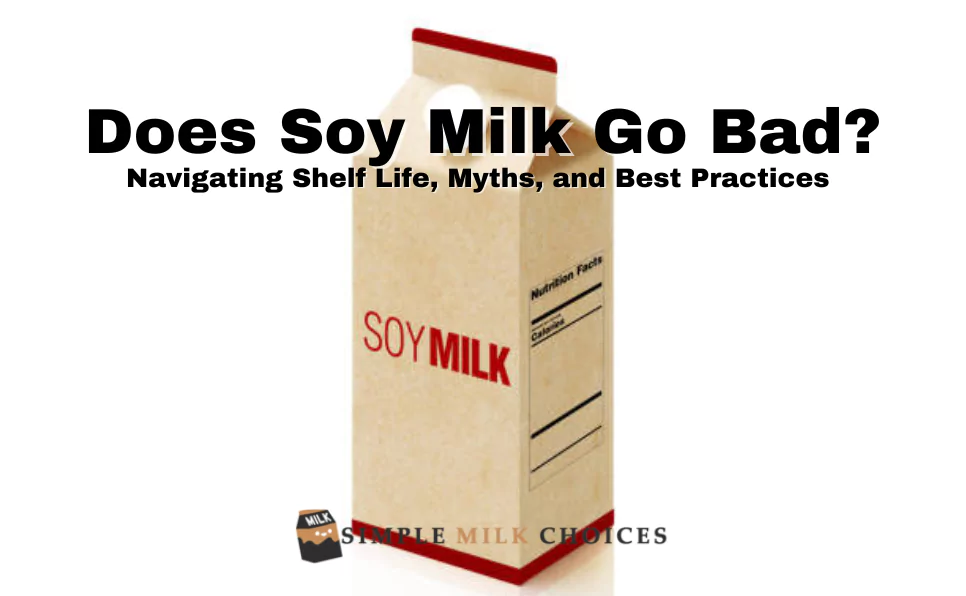Soy milk, a beloved dairy option considered for its medical advantages, has turned into a kitchen essential. However, as consumers progressively go to this plant-based choice, a squeezing question emerges: Does soy milk go bad? In this comprehensive article, we will look into the complexities of soy milk’s duration of usability, clarify common misconceptions, and give reasonable tips to ensure your soy milk remains fresh for longer.
The Shelf Life of Soy Milk
A. Factors Impacting Timeframe of Realistic Usability
Factors that shorten the shelf life of soy milk can affect it, just like other perishables. A nuanced comprehension of these components is crucial for keeping up with the freshness and nature of your soy milk.
1. Packaging: A Guardian or Culprit?
The type of packaging can be soy milk’s best partner or its worst enemy. Aseptic cartons, designed to protect the item from light and air, are regularly utilized. In any case, the integrity of the bundling is critical, as any trade-off can go to waste.
2. Storage Requirements: The Cool Hug of Freshness
Proper capacity is undeniable. Refrigeration is basic, given soy milk’s resistance to bacterial pollution at room temperature. The meaning of steady, cool temperatures couldn’t possibly be more significant, and variances should be limited.
3. Expiration Dates: A Guide, Not a Gospel
While producers give termination dates as a rule, they are not dependable. Soy milk expiration dates are estimates, and various factors can affect them.
B. Understanding Expiration Dates on Soy Milk Containers
Unwinding the secret behind lapse dates includes thinking about extra factors past the printed date. Proper storage, dealing with, and awareness of your soy milk’s journey from creation to your refrigerator all contribute to a more precise evaluation of its freshness.
C. Indications of Soy Milk Going Bad
Perceiving the warnings of spoilage enables consumers to pursue informed decisions. Changes in variety, smell, and surface act as pointers, and a more profound exploration of these signs is significant for surveying the health and tastefulness of your soy milk.
Detailed Instructions for Storing Soy Milk Properly
A. Refrigeration Tips: Chilling Insight
It is important to keep a reliably chilly temperature. Fridges set at or beneath 40°F (4°C) are ideal for easing back bacterial development and protecting the purity of the creation of soy milk.
B. Significance of an Airtight Container: Protecting from Oxidation
Oxygen is a quiet enemy in the fight against crumbling food. Soy milk can be kept fresher for longer by storing it in airtight containers, which act as a protective barrier by reducing oxygen exposure and slowing down the oxidation process.
C. Avoiding Being Open to Light and Intensity: A Pair of Crumbling
Light and intensity are impressive enemies. Putting soy milk in dark containers, protected from direct sunlight and intensity sources, is a crucial step in maintaining its integrity and halting its premature deterioration.

Common Misconceptions
A. Myth-Busting: Does Soy Milk Last Longer than Dairy Milk?
Dispelling common misconceptions regarding the shorter shelf life of soy milk in comparison to its dairy counterpart is crucial for well-informed, autonomous guidance. While soy milk is frequently praised for its more drawn-out duration of usability, understanding the elements at play is essential. Dissimilar to dairy milk, soy milk doesn’t contain the proteins and sugars that encourage bacterial development, giving it a more drawn-out life by and large. In any case, this doesn’t make it resistant to deterioration.
Additionally, the myth that soy milk naturally lasts longer could lead to disdain for proper capacity exercises. Consumers should perceive that, no matter what the milk type, adherence to capacity rules is paramount to ensuring freshness.
B. Tending to Worry about Additives in Soy Milk
There’s a relentless worry among consumers about the utilization of additives in soy milk. While a few business assortments might contain additives to expand the duration of realistic usability, these added substances are, for the most part, safe when utilized inside administrative cut-off points. Normal additives like citrus extract or vitamin E are cell reinforcements that assist with keeping up with the nature of soy milk by preventing oxidation.
Tending to these worries includes advancing attention to the types and measures of additives utilized. It’s vital to stress that administrative bodies thoroughly test and endorse food-added substances for wellbeing before they arrive at consumers.
C. Dispersing Misconceptions about the Effect of Added Substances on Duration of Usability
Soy milk often adds stabilizers, emulsifiers, and fortifiers to improve its texture, prevent separation, and boost nutritional content. Misguided judgments about the adverse effects of these added substances on the duration of usability can deflect shoppers.
In all actuality, these added substances go through thorough testing to ensure they satisfy wellbeing guidelines. Understanding the motivation behind every added substance assists consumers with making informed decisions. Stabilizers, for example, add to the smooth surface of soy milk, while fortifiers improve its wholesome profile.
Testing Soy Milk for Freshness
A. Simple Smell and Taste Tests
A tactile assessment of soy milk is a powerful method for measuring its freshness. Prior to opening the holder, give it a delicate shake to ensure consistency. Once opened, pause for a minute to smell the soy milk. A new group ought to have a gentle, somewhat wonderful fragrance. Any acrid or obnoxious scents might demonstrate waste.
Then, taste a modest quantity. New soy milk offers an unobtrusive, somewhat nutty flavor that enhances the overall taste of soy milk. Any sharpness or upsetting taste suggests it could be over the hill. These straightforward tests give important insights into the soy milk’s condition.
B. Visual Indicators of Decay
Obvious signals are additionally demonstrative of soy milk’s freshness. Check for changes in variety or consistency. Fresh soy milk normally has a smooth, grayish variety. On the off chance that you notice any detachment, souring, or adjustment of variety towards yellow or brown, it’s an indication that the soy milk might be beginning to ruin.
Review the compartment for any indications of expansion or spillage, as these could be indications of bacterial pollution. Being mindful of these visual pointers helps with the early location of decay.
C. Importance of Detachment or Coagulating Inspection
Understanding the peculiarities of partition and turning sour is essential for evaluating the freshness of soy milk. These progressions can happen because of fluctuations in temperature or broadened stockpiling periods. Watchfulness in checking for these adjustments assists consumers with coming to informed conclusions about the security and nature of their soy milk.

Expanding the Duration of Usability of Soy Milk
A. Freezing Soy Milk: Advantages and Disadvantages
Freezing soy milk is a down-to-earth technique to expand its duration of usability, particularly when confronted with the possibility of approaching its termination date. It stops bacterial development and enzymatic movement, which protects the milk’s quality. However, understanding the potential drawbacks is essential.
While freezing doesn’t essentially change the wholesome substance, it can affect the surface. Defrosted soy milk might display changes in consistency, and some partition could happen. To moderate this, think about shaking the holder well in the wake of defrosting. In spite of these ideas, frozen soy milk remains a flexible element for different culinary applications.
B. Methods for Defrosting and Utilizing Previously Frozen Soy Milk
While defrosting frozen soy milk, a progressive methodology is ideal. Move the frozen compartment to the fridge, permitting it to gradually defrost. Abstain from involving a microwave for quick defrosting, as this might add to bothersome surface changes.
Once defrosted, shake the holder to reintegrate any isolated parts. Frozen soy milk is appropriate for use in cooking and baking, where changes in surface might be less observable. Creative recipes like smoothies, soups, and heated merchandise can profit from the utilization of recently frozen soy milk.
C. Imaginative Ways Of Utilizing Soy Milk Before It Turns Sour
Preventing soy milk from going to waste includes imagination in the kitchen. While approaching its lapse date, consider integrating soy milk into different recipes. Smoothies, oats, and espresso drinks can be improved with soy milk. Furthermore, utilizing soy milk in cooking and baking adds a rich surface to dishes, making it a flexible ingredient in both sweet and flavorful applications.
Exploring different ways regarding custom-made soy-based recipes, like tofu or soy yogurt, gives an amazing opportunity to capitalize on soy milk before it reaches the end of its realistic usability. By embracing culinary imagination, consumers can enjoy soy milk in different ways, limiting food squander.
Also Read: Creamy Milk Delights: Must-Try Dish Recipes
Conclusion: Final Thoughts
A. Recap of Central Issues
- A summary of the primary focus points from the study of soy milk’s time duration and realistic usability
- Highlighting the importance of lawful stockpiling, comprehending expiration dates, and recognizing signs of spoilage
B. Engaging Readers to Come to Informed Conclusions about Soy Milk
- Empowering perusers to apply the information acquired from the article to settle on informed decisions about buying, putting away, and drinking soy milk underscores the job of individual obligation in ensuring food handling.
FAQs about Soy Milk Expiration
Can you consume soy milk after the expiration date?
The printed expiration date on soy milk fills in as a rule, yet it isn’t ensured to mean the item is dangerous after that date. Directing tangible tests, for example, smell and taste checks, is crucial. On the off chance that the soy milk shows up and smells ordinary, it’s likely safe to consume. However, any recognizable disconcerting scents or flavors demonstrate waste, and disposing of the product is fitting.
What should you do if soy milk has an offensive smell or taste?
If your soy milk shows an uncommon scent or taste, choose caution and refrain from consuming it. Strange smells or flavors might show that there is bacterial pollution or deterioration. Disposing of the item is the most secure way to keep away from potential wellbeing gambles.
Are there health risks associated with drinking expired soy milk?
Although using soy milk after its expiration date may not always pose immediate health risks, proper food handling practices are crucial. Any deviation from the standard qualities, like disconcerting scents, flavors, or changes apparently, ought to be treated in a serious way. Practicing alertness and sticking to legitimate capacity practices can essentially limit the potential risks associated with consuming expired soy milk.
You can read more about health concerns with soy milk here.





